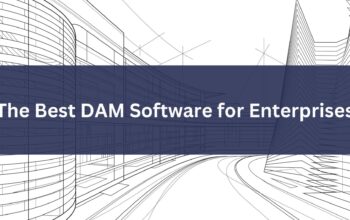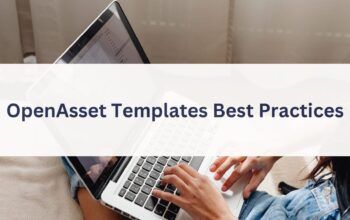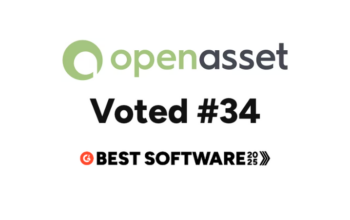When you’re an AEC firm trying to manage an ever-growing library of digital assets efficiently, a Digital Asset Management (DAM) system is not just an advantage—it’s a necessity. However, these industries require a DAM solution that is designed specifically for these industries and offers a powerful suite of AEC tools.
So, which DAM software checks all the boxes for AEC firms? OpenAsset. As a leader in the DAM space, OpenAsset exceeds traditional DAM features to address the unique challenges faced by project-driven organizations.
But what makes OpenAsset a game-changer for AEC professionals? In this blog, we dive deep into the top OpenAsset features that every user should know. From its AI-powered search capabilities to its seamless project-based structure, we’ll explore how OpenAsset is revolutionizing the way firms manage, share, and leverage their digital assets.
By the end of this blog, you’ll have a better understanding of the key OpenAsset functionalities and how they help your AEC firm create winning proposals and win more business.
What Is OpenAsset?
OpenAsset is a Digital Asset Management (DAM) software designed for AEC firms. It provides a centralized platform for these firms to manage, organize, and share digital assets such as photographs, design files, branding materials, and project documents.
Specifically, OpenAsset features are tailored to support the unique needs of project-driven organizations, enabling them to catalog and find assets based on project metadata effectively.
Moreover, OpenAsset facilitates improved collaboration among team members and stakeholders by streamlining access to digital content. This helps enhance marketing efforts, proposal creation, and project presentations through easy access to relevant assets.
Who Needs OpenAsset?
As mentioned above, OpenAsset features are particularly beneficial for firms and organizations within architecture, engineering, and construction. These industries often manage large libraries of project-specific digital content, including photographs, design documents, CAD files, and marketing materials.
Moreover, AEC firms rely on high-quality visuals and project documents to respond to RFPs and showcase their work to potential clients and stakeholders. Therefore, OpenAsset helps them organize, manage, and share these assets efficiently, enhancing their ability to create compelling presentations and proposals.
Specifically, marketing professionals at AEC firms need efficient ways to manage and repurpose digital assets across various platforms. OpenAsset supports these efforts by providing tools for organizing, tagging, and distributing marketing collateral. They also have automated ways to create project sheets, resumes, and other AEC deliverables.
Top OpenAsset Features
On G2’s ‘OpenAsset Features’ page, OpenAsset ranks above average in every digital asset management category:
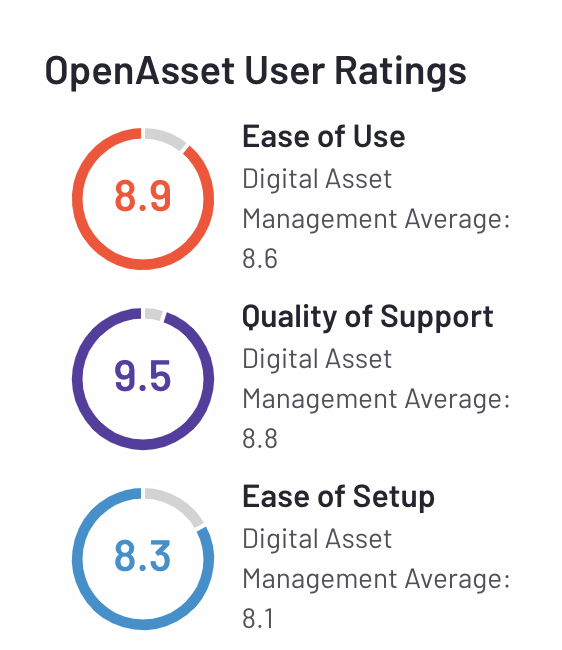
Whether you’re already an OpenAsset user or considering its implementation within your organization, this section will highlight the key features that set OpenAsset apart as a leading digital asset management solution.
1. Metadata and Tagging
With OpenAsset, you’re not just organizing your assets; you’re creating a system that aligns perfectly with the way your firm operates. The platform gives you the flexibility to categorize and manage your digital content in a manner that makes accessing and using these assets as intuitive and efficient as possible.
Your files become effortlessly discoverable through customized metadata. This system allows you to tag your assets with project-specific keywords automatically, ensuring that keywords at the project level are instantly applied to related files, streamlining the search process and enhancing productivity.
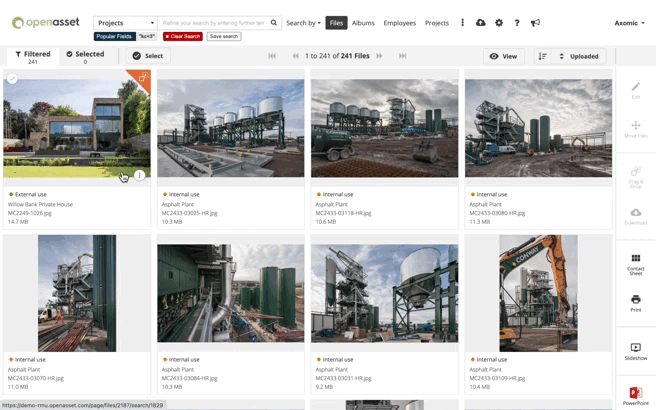
The ability to create custom fields to store relevant information alongside your files transforms your digital asset library into a powerhouse of searchable data. Whether it’s specific project details, client information, or unique asset attributes, the metadata you curate with OpenAsset is instantly searchable, making it a breeze to find exactly what you need when you need it.
2. Advanced Search
OpenAsset is designed to ensure every piece of your digital content is easily searchable and accessible to your entire team and organization. With OpenAsset, discovering your top digital assets becomes a breeze.
OpenAsset’s search features are carefully designed to cater to the dynamic needs of the AEC firms. Applying keywords and metadata to your projects is straightforward, streamlining the process of retrieving these assets in the future with minimal effort.
Additionally, OpenAsset simplifies the process of finding digital assets by allowing users to search based on projects or properties. This functionality enables teams to quickly access all relevant assets associated with specific projects, streamlining workflow and enhancing productivity.
Leveraging keywords that include an entire project—such as the city, client name, or project type—teams can effortlessly locate groups of digital assets. This broad, yet effective approach to categorization ensures that finding assets related to specific themes or clients is straightforward and fast.
With digital assets carefully stored by project or property and with all the relevant metadata your team requires, searching for and finding the best files is not just possible but effortlessly efficient.
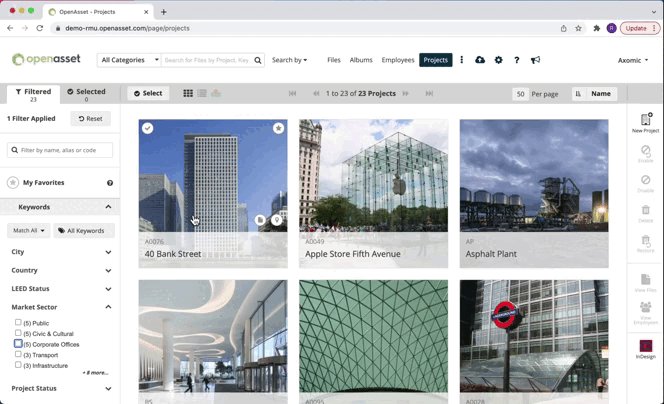
Moreover, OpenAsset enables searches based on file-specific identifiers, such as building elements or materials used. This level of detail ensures that AEC marketers, business development managers, and/or pursuit teams can find exactly what they need, whether they’re looking for examples of specific materials or design elements.
Lastly, by leveraging OpenAsset’s advanced search capabilities, you and your team can explore a wider array of options through image similarity, broadening your selection choices.
Based on taxonomy and the way you decide to configure your OpenAsset system, you can have powerful search capabilities that ensure your team can find the perfect assets for any project, presentation, or proposal with unprecedented speed and efficiency.
3. The Employee Module
The Employee Module boosts your organization’s efficiency by streamlining the creation of RFP resume documents. You can create employee resumes within minutes to use with bids and proposals through OpenAsset.
Your project teams represent your most significant asset, and OpenAsset simplifies the process of highlighting their skills. By storing employee information and associating employees with their respective projects, you enhance the visibility of their contributions.
Additionally, the Employee Module streamlines your workflow by enabling seamless synchronization of employee information between OpenAsset and your CRM or ERP systems, all done automatically. Integrating your CRM or ERP system data with OpenAsset creates more cohesive and streamlined workflows.
Here are some key Employee Module features:
- Store comprehensive employee data along with defined headshots, ensuring that resumes and marketing materials always feature the most current and professional images.
- Connect your employees with relevant digital assets and projects based on their roles. This feature allows for a dynamic showcasing of each team member’s contributions to projects.
- With formatted InDesign templates, generating employee resumes becomes as simple as a click of a button. Whether you need to create resumes for individuals or entire teams, OpenAsset minimizes effort and maximizes efficiency.
- Recognizing the importance of accurate and consistent employee-related data, OpenAsset integrates with systems like Deltek or Unanet, serving as the single source of truth.
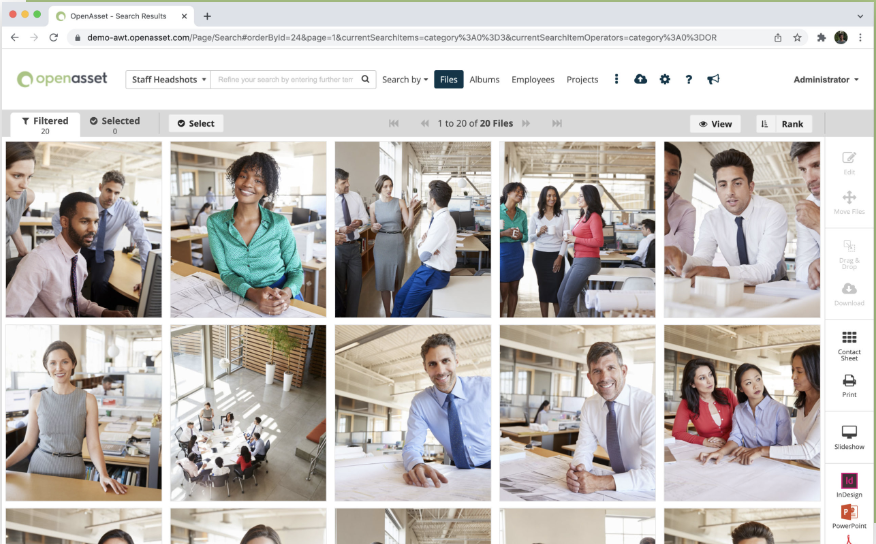
Moreover, OpenAsset’s Employee Module is more than just a tool for managing digital assets; it’s a comprehensive solution for showcasing your team’s talents and achievements. The ability to effortlessly highlight their team’s expertise, streamline resume creation, and ensure data accuracy gives your team a competitive edge in the market.
With the Employee Module, AEC firms can focus on what matters most – winning new business and showcasing your team’s expertise.
4. Advanced AI
Incorporating artificial intelligence (AI) into your tech stack can significantly enhance process efficiency and streamline operations. OpenAsset goes beyond just helping you locate the files you need; it leverages AI to introduce you to similar assets.
Leveraging AI, OpenAsset enhances your ability to discover images that share similar AEC characteristics throughout your database. This goes beyond basic digital asset management; it’s about discovering images with similar features, enriching your options, and simplifying the selection process.
The ability to find images based on similar features makes batch editing simple. You can find and select groups of images and add relevant keywords across all of them at one time.
Moreover, AI Suggested Keywords in OpenAsset offers a streamlined approach to tagging images. This innovative feature not only simplifies the process of manual tagging but also helps AEC firms in developing and broadening their taxonomies with both general and industry-specific keyword suggestions for every image.
Additionally, OpenAsset’s Content Assist feature, powered by Generative AI, empowers users to quickly generate project descriptions and employee bios by utilizing existing Project and Employee data.
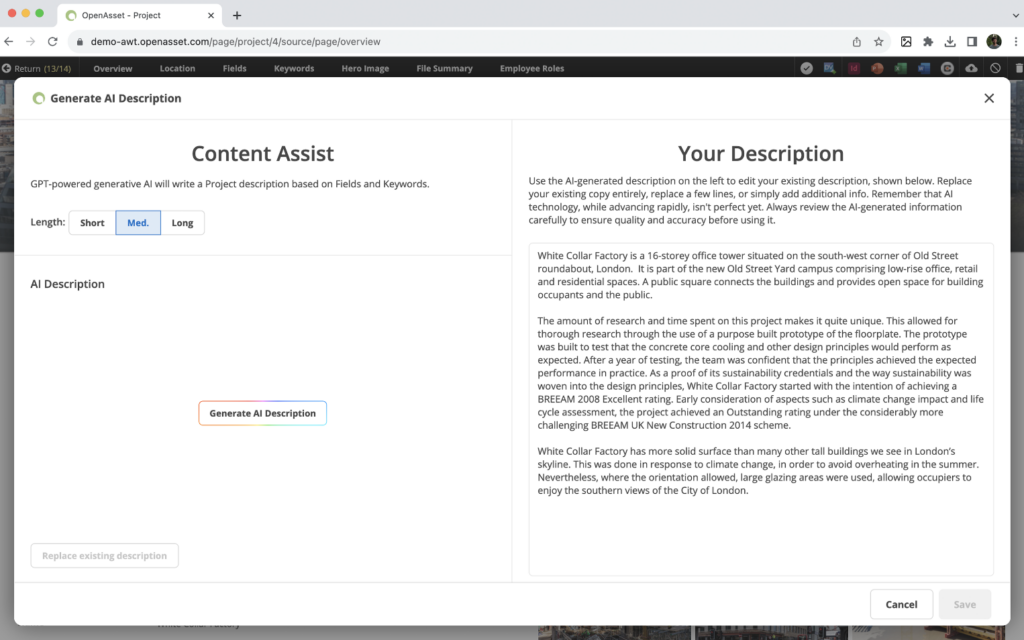
This accelerates content creation and ensures consistency and relevance across your digital asset management efforts.
5. Industry-Specific Integrations
OpenAsset, designed with AEC professionals in mind, seamlessly integrates with the tools and software that are staples in these fields. It offers robust connections to the CRM and ERP systems that AEC firms rely on. Integrating OpenAsset enables your team to create documents easily and effectively.
By integrating with your ERP, CRM, or project management systems, you streamline data management and enhance the connectivity of your operations. These integrations facilitate a more efficient workflow for managing digital assets and various aspects of project management. To learn more about project management for AEC visit our resource here.
Additionally, OpenAsset enhances document production by integrating with essential tools like InDesign for easy access to your asset library. You save time by dragging and dropping images straight from your DAM into InDesign or PowerPoint.
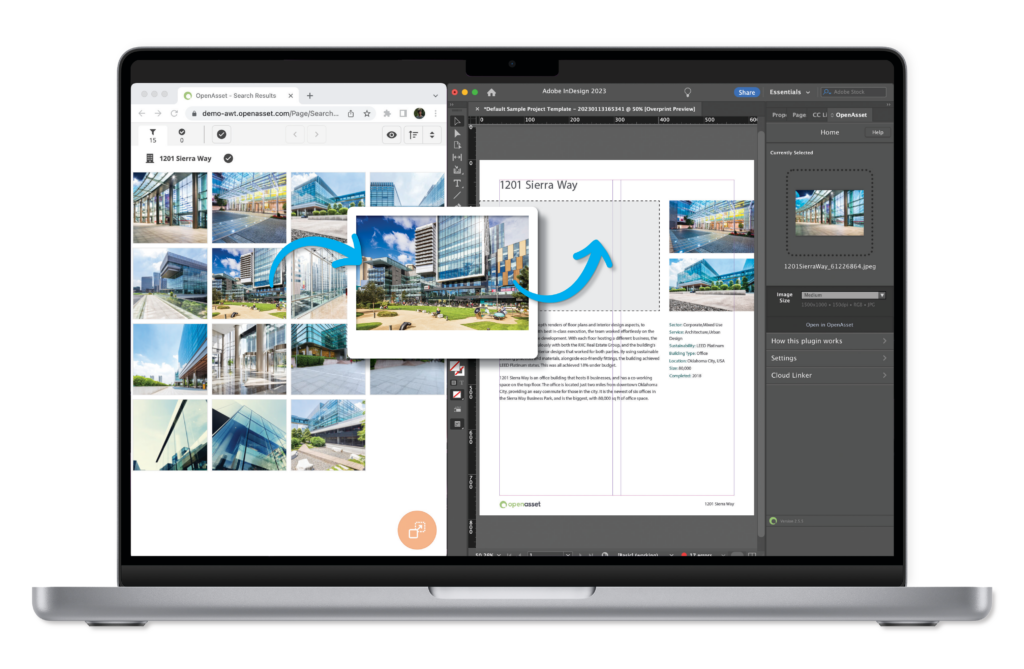
Another major benefit of integrating your tools is that there will be no more broken links. The integration automatically saves and preserves all image links— so you can build documents with images stored in the cloud.
This integration eliminates the need for separate searches and downloads, saving valuable time and ensuring consistency across your projects. With OpenAsset, you have the confidence that every piece of material produced is of the highest quality.
OpenAsset Integrations
- Procore
- AEC 360
- Deltek Vision
- Deltek Vantagepoint
- Affinity
- Microsoft Word, PowerPoint, and Excel
- Okta
- Salesforce
- Unanet/ Cosential CRM
- Templafy
- InDesign
Moreover, OpenAsset’s REST Application Programming Interface (API) enables tailored custom integration and functionality. This allows businesses to create custom solutions or integrations that align precisely with their unique needs and operational processes.
Third-party integrations make it easy to connect applications through triggers that kick off automated workflows. For example, you can connect OpenAsset to your CMS and automate a project creation in OpenAsset when you win an opportunity in Salesforce.
By linking OpenAsset with your CMS platform, such as WordPress, you can ensure images on your website are automatically updated. And it works both ways. Not only can you automatically upload new images to your CMS when they are uploaded to your DAM, but you can automatically upload images to your DAM when they’re uploaded to your CMS. Essentially, the systems are talking to each other.
Such integrations facilitate seamless integration into existing workflows, minimizing disruptions and enhancing the utilization of current technological investments, thereby significantly increasing productivity.
6. Customized Templates
Creating custom templates significantly enhances the document creation process’s efficiency and uniformity across organizations. The advantages of integrating templates into your OpenAsset system are manifold:
- Direct integration of resized images and project data from OpenAsset into your documents, streamlining the document creation process.
- Centralized management of your organization’s approved, brand-compliant documents, ensuring consistent use of up-to-date templates by all team members.
- The ability to quickly adapt to rebranding efforts by simply updating the foundational template, saving time and resources.
- Flexibility in exporting custom templates from OpenAsset to various software platforms, including Adobe InDesign, Affinity Publisher, Microsoft PowerPoint, and Microsoft Word.
Customized templates allow users to efficiently create consistent, brand-aligned documents, presentations, and marketing materials directly within the OpenAsset system. However, to better serve your team’s specific needs, you’ll have to specify the software from which you’d like the template to be exported.
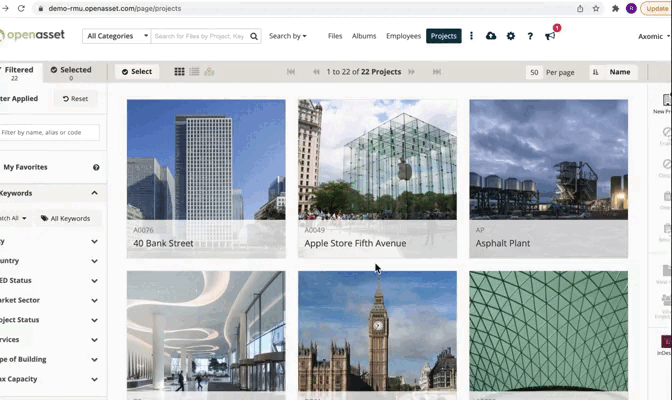
Here are the different types of templates and workflows you can create with OpenAsset:
- Project-Based templates: Your team’s workflow will be to select one or more projects. The resulting document will contain each project’s images and data that you discuss with OpenAsset. These templates default images by rank/marketing preference.
- File-Based templates: Your team’s workflow will be to select the individual photography files that will export onto your template. The resulting document will contain those images and any associated data you discuss with OpenAsset.
- Employee-Based templates: Your team’s workflow will be to select one or more employees. The resulting document should contain a headshot of the employee, their metadata, the projects they’re assigned to, and those projects’ associated data you’ve discussed with OpenAsset.
These customized templates in OpenAsset offer a powerful feature for firms looking to streamline their marketing and project documentation processes.
7. Control Access
OpenAsset’s Access Control Features offer robust management and security for your digital assets, ensuring that the right people have the right access, both within your organization and externally.
This powerful functionality allows you to carefully control who can view and use collections of digital assets, streamlining the process of maintaining a cohesive brand image. By standardizing and sharing marketing-approved assets across your company, OpenAsset makes it easier than ever to manage your brand effectively.
With Access Levels, OpenAsset elevates your ability to curate and present the most appropriate files for any situation—whether for promotional purposes, ensuring copyright compliance, or other specific needs. These Access Levels extend further capabilities, such as archiving outdated assets or imposing restrictions on files that are no longer relevant, ensuring your digital library remains current and compliant.
Moreover, OpenAsset enhances security and organization through the use of permission groups. This feature grants you the authority to determine which digital assets are searchable and accessible, providing an added layer of control over your digital content.
OpenAsset also gives you control over who can upload files, add keywords, and manage metadata. These Access Control Features in OpenAsset not only protect your digital assets but also optimize their use across your business, ensuring that your team works more efficiently and your brand is consistently represented at its best.
Save Time and Create Higher-Quality Proposals With OpenAsset
With the top OpenAsset features mentioned in this article, OpenAsset streamlines the process of storing, finding, using, and sharing digital assets.
The idea behind OpenAsset is simple: Centralize AEC assets. Create more proposals. Win more business. OpenAsset’s DAM platform makes AEC proposals simpler, faster, and more successful.
That’s why 99% of customers renew.
Ready to experience OpenAsset for yourself? Schedule a demo with one of our solution experts.



